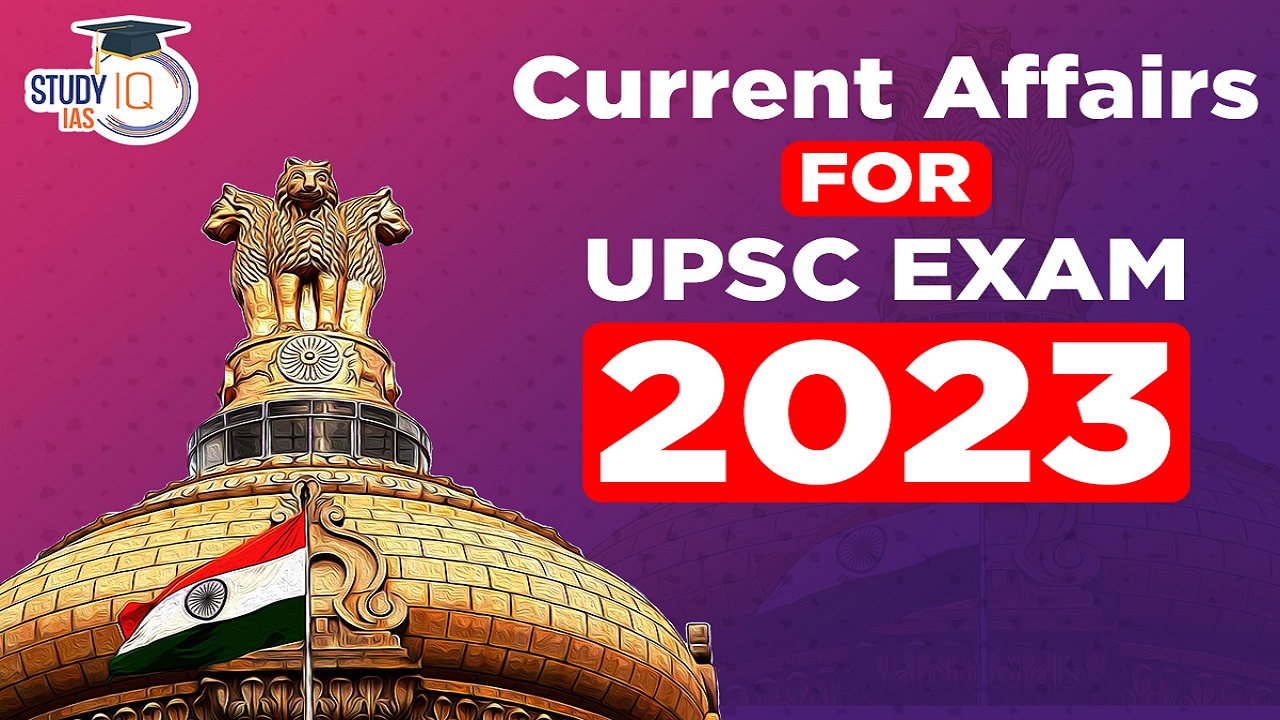Current Affairs 17th May 2023 for UPSC Prelims Exam
Union Public Service Commission
Context: Manoj Soni has been sworn in as the Chairman of the Union Public Service Commission (UPSC).
About Union Public Service Commission (UPSC)
- History: Post Lord Macaulay’s Report of the Select Committee of British Parliament, the concept of a merit based modern Civil Service in India was introduced in 1854.
- Initially, the examinations for Indian Civil Service (ICS) were conducted only in London. Maximum age was 23 years and minimum age was 18 years.
- The first Indian to enter the ICS through the competitive exams in London was Satyendranath Tagore in 1863.
- The Government of India Act 1919 provided for establishment of Public Service Commission in India.
- From 1922 onwards, the ICS Examination was held in India, first in Allahabad and later in Delhi with the setting up of the Federal Public Service Commission.
- With the inauguration of the Constitution of India in January 26, 1950, the Federal Public Service Commission came to be known as the Union Public Service Commission.
- UPSC: It is the central recruiting agency in India. It is an independent constitutional body as it has been directly created by the Constitution.
- Constitutional Provisions:
- Article 315: Constitution of Public Service Commissions (PSC) for the Union and for the States of India.
- Article 316: Appointment and term of office of members.
- Article 317: Removal and suspension of a member of Public Service Commission.
- Article 318: Power to make regulations for the conditions of service of members and staff of the Commission.
- Article 319: Prohibition of holding the office by members of Commission upon ceasing to be such members.
- Article 320: Functions of Public Service Commissions.
- Article 321: Power to extend the functions of Public Service Commissions.
- Article 322: Expenses of Public Service Commissions.
- Article 323: Reports of Public Service Commissions.
- Composition of UPSC:
- Appointment of Members: The Chairman and other members of the UPSC are appointed by the President of India.
- Term of Office: Any member of the UPSC shall hold office for a term of six years or till the age of 65 years, whichever is earlier.
- Reappointment: The Chairman of the UPSC shall be ineligible for further employment either under the Government of India or State.
- A member other than the Chairman of the UPSC shall be eligible for appointment as the Chairman of the UPSC or as the Chairman of a State Public Service Commission, but not for any other employment.
- Resignation: A member of the UPSC may resign from his/her office by submitting the written resignation to the President of India.
- Removal/Suspension of Members: The Chairman or any other member of UPSC shall only be removed from his/her office by order of the President of India.
- The President can suspend the Chairman or any other member from his/her office in respect of whom a reference has been made to the Supreme Court.
- Regulating the Conditions of Service: The President of India shall:
- Determine the number of members of the Commission and their conditions of service.
- Make provisions with respect to the number of members of the staff of the Commission and their conditions of service.
- Power to Extend Functions: An Act made by the Parliament, or the Legislature of a State may provide for the exercise of additional functions by the Union Public Service Commission or the State Public Service.
- Expenses of UPSC: The expenses of the UPSC including salaries, allowances and pensions are charged on the Consolidated Fund of India.
- Submission of Reports: It shall be the duty of the Union Commission to present annually to the President a report as to the work done by the Commission.
Current Affairs 16th May 2023 for UPSC Prelims Exam
Appointment of Supreme Court Judges
Context: The five-member Supreme Court collegium has proposed to the government the appointment of Andhra Pradesh Chief Justice Prashant Kumar Mishra as a Supreme Court judge.
What is the Collegium System?
- The Collegium system in India also called “Judges- selecting- Judges”, is an internal mechanism of the judiciary, where the judges are appointed and transferred only by the judges.
- The system has evolved by means of the judgments of the Supreme Court, and not by an Act of Parliament or by a Constitutional provision.
- Composition of the collegium:
- The Supreme Court Collegium is headed by the Chief Justice of India and comprises 4 other senior-most judges of the SC.
- A High Court collegium is headed by its Chief Justice and 4 other senior-most judges of that court.
Procedures for the judicial appointments by the collegium
- For appointing Chief Justice of India (CJI):
- The President of India appoints the CJI and the other SC judges.
- The outgoing CJI recommends his successor.
- In practice, it has been strictly by seniority ever since the supersession controversy of the 1970s.
- For appointing other SC Judges:
- SC judges are recommended by a Collegium consisting of the CJI and 4 senior-most judges of SC.
- The Collegium recommends the candidate to the Law Minister, who forwards it to the Prime Minister who then advises the President for the final appointment.
- For appointing Chief Justice of High Courts:
- President appoints CJ of HC in consultation with CJI (consults other SC collegium members) and governor of the respective state.
- The candidate is selected from outside the respective state.
- For appointing other HC judges: HC judges are also appointed by the President who consults the HC Collegium (CJ of HC and 4 senior-most HC judges), CJI (consults other SC collegium members), and the Governor of the respective state.
- For appointing Judges of Common HC: Judges of common HC are appointed by the President who consults CJI (consults other SC collegium members) and Governors of respective states.

Burachapori Wildlife Sanctuary
Context: Recently, Assam Chief Minister’s office shared photographs of the successful anti-encroachment drive at Burachapori Wildlife Sanctuary.
About Burachapori Wildlife Sanctuary
- The Burachapori wildlife sanctuary in Assam is located in the Sonitpur district of Assam.
- The area was declared a reserved forest in 1974; it became a sanctuary in 1995.
- It is located on the southern bank of river Brahmaputra.
- Burachapori Wildlife Sanctuary is actually a part of the Laokhowa Wildlife Sanctuary.
- These two wildlife sanctuaries in Assam have two different names, they are eologically and geographically a singular entity. 60% of the sanctuary is grassland.
- Burachapori sanctuary is well-known for the Bengal Florican and One-horned Rhinoceros.
- Mammals: Tiger, Leopard, Wild Buffalo, Hog Deer, Wild Pigs etc. and occasional visit of herd of Elephants.
- Birds: Bengal Florican, Swamp partridge (fancolin), Wood Cock, Water Hen, Parakeets, Ferruginous Duck etc.
Alzheimer Drug
Context: Recently, Donanemab drug was found to slow down cognitive decline by 35% in people with early Alzheimer’s.
About Alzheimer
- It is a neurological disorder which causes brain cells to degenerate and die. This leads to loss of memory, problems with words in speaking or writing, poor judgment, changes in mood and personality, confusion with time or place, etc.
- At the first stage, these symptoms are mild but they become more severe with time.
- Alzheimer’s is the most common cause of dementia among older adults.
- Cause: Alzheimer’s disease is thought to be caused by the abnormal build-up of proteins in and around brain cells.
- One of the proteins involved is called amyloid, deposits of which form plaques around brain cells and the other protein is called tau.
- Treatment: Currently there is no known cure for Alzheimer’s disease.
- An estimate suggests that India’s burden of dementia, of which Alzheimer’s is a part, will increase to 14 million by 2050.
About Donanemab Drug
- Donanemab is a monoclonal antibody that targets the abnormal plaques of amyloid beta protein characteristically seen in brain images of those with Alzheimer’s.
- Its mechanism of action is similar to Lecanemab, the drug developed by Japanese and American companies Eisai and Biogen that received a fast-track approval from the FDA earlier this year.
- Aducanumab was the first Alzheimer’s drug to receive approval in 2021.
- 35% slower cognitive decline is measured using a scale called integrated Alzheimer’s Disease Rating Scale (iADRS).
- Potential side effect: Temporary swelling and tiny bleeds in the brain, called amyloid-related imaging abnormalities (ARIA). Researchers believe this class of monoclonal antibodies weaken blood vessels as they attack the amyloid plaques.

Dengue Vaccine
Context: India is moving closer to developing its first-ever vaccine against dengue.
About Dengue
- Dengue or break-bone fever is a viral infection that spreads from mosquitoes to people, causing a significant number of deaths across the world.
- Dengue virus is transmitted through the bite of a female Aedes mosquito.
- Aedes is a daytime feeder and can fly up to a limited distance of 400 meters.
- Dengue mosquitoes can’t breed once the temperature falls below 16 degrees.
- According to the World Health Organisation, about half of the world’s population is now at risk of dengue with an estimated 100–400 million infections occurring each year.
- Burden in India: According to the National Center for Vector Borne Diseases Control, 1,93,245 cases of dengue and 346 deaths were reported across the country in 2021.
- Last year, more than 30,000 people contracted dengue with the numbers rising during the peak monsoon season.
- Every year, from July to November, an upsurge in cases of dengue disease can be observed mainly because of water logging, and unhygienic areas.
- The disease has a seasonal pattern, which means that the peak comes after the monsoon.
| Occurrence | Dengue is an illness that is prevalent in tropical and subtropical areas of the world. |
| Pathogen | Dengue is caused by a virus of the Flaviviridae family. |
| Spread | The infection spreads from one person to another through Aedes mosquitoes, which act as vector.
There is also a possibility of maternal transmission between pregnant mother and the baby. |
| Symptoms | General symptoms include fever, vomiting, nausea, muscle pain, headache, swollen glands, rash etc.
Severe symptoms are bleeding from gums, blood in stool and urine, severe stomach pain, fatigue etc. |
| Mortality | Mild dengue causes a high fever and flu-like symptoms. The severe form of the illness, called dengue hemorrhagic fever, can cause serious bleeding, a sudden drop in blood pressure and death. |
| Prevention and treatment | The best preventive measure is to avoid being bitten by mosquitoes and to take steps to reduce the mosquito population.
The vaccine Dengvaxia has been approved by regulatory authorities in many countries. |



 TALASH Initiative: Objective, Key Featur...
TALASH Initiative: Objective, Key Featur...
 Custodial Deaths in India, Types, Issues...
Custodial Deaths in India, Types, Issues...
 MPPSC FSO Recruitment Notification 2025 ...
MPPSC FSO Recruitment Notification 2025 ...





















